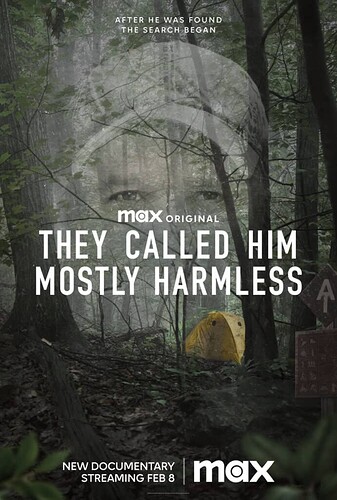Originally published at: Unveiling the Mystery: A Deep Dive into Patricia Gillespie's 'They Called Him Mostly Harmless - People of Con
Article: Tia Brisco
Have you ever wondered what it’s like to dive into the depths of a true crime mystery, unraveling each thread to reveal a hidden truth? This is the world Patricia E. Gillespie immerses us in with her latest film, They Called Him Mostly Harmless, premiering on Max today, Thursday, February 8, 2024. I recently had the incredible opportunity to sit down with Gillespie, a Brooklyn-based filmmaker whose passion for unearthing the untold stories of underdogs shines through her work. Her unique upbringing as the daughter of a cable splicer and a seamstress has fueled her drive to craft narratives that resonate with authenticity and grit, as seen in her previous works, including The Devil You Know.
In They Called Him Mostly Harmless, Gillespie takes us on a riveting journey through the Florida wilderness, where the mysterious case of a deceased hiker unfolds. Discovered on July 23, 2018, without wallet, phone, or identification, and yet with cash and food supplies, the hiker presents a puzzle.
The film delves into the world of Internet sleuths, portraying their dedicated efforts to aid victims by unraveling mysteries in their spare time. Despite personal challenges, such as caregiving for family members and parenting responsibilities, these sleuths are driven by a profound sense of purpose. They are committed to restoring the identity of the man known as, Mostly Harmless, and reconnecting him to his family. This narrative goes beyond the mere pursuit of a name; it’s an intricate exploration of identity, human connection, and the intersection of digital trails with real-world enigmas. By highlighting both the virtues and pitfalls of internet-fueled detective work, the story presents a captivating insight into the complexities of this true crime tale, emphasizing the power and impact of online communities in solving real-life mysteries.
Our conversation began with Gillespie’s vision for the film: to tell a story and evoke emotions and thoughts from the audience that result in us asking ourselves who we are and how we are perceived. It reflects how we often discover parts of ourselves in searching for someone else.
In the film, the Internet emerges as a tool and a character in its own right. Gillespie shared in the interview, “The way your internet persona, either the one you create or the one that’s created for you, can be so disconnected from who you are in life… It’s a little microcosm for how we treat each other online.” This perspective brings a fascinating layer to the documentary, highlighting how our digital lives intertwine with our real ones, shaping perceptions and narratives. It’s a thought-provoking reflection on our era of digital connectivity and its impact on individual stories and collective consciousness.
What struck me most was the emphasis on the individuality of the hiker, known as Mostly Harmless. He is portrayed as a multifaceted character. From the outside, he seemed like a solitary hiker on a personal journey, well-liked by those he encountered on the Appalachian Trail. However, the revelation of his identity led to startling discoveries about his life, including strained family relations and troubling personal history. This dual portrayal challenges the typical narratives of true crime stories, showing the stark difference between public perception and complex personal realities. This documentary reminds us that behind every headline, there’s a human story waiting to be told.
As a community that values mental health, social justice, and representation, They Called Him Mostly Harmless challenges us to think about how we perceive strangers and the narratives we construct around them. It’s a reminder of the power of empathy and the importance of giving voice to the voiceless.
Gillespie also touched upon a fascinating aspect of the true crime genre – it’s audience is often women. She noted, “The viewership of true crime is primarily female… We gravitate toward these stories not because of the lurid details but because of empathy.” This empathy-driven engagement is echoed in research showing that women are more likely than men to consume true crime media, drawn to the educational and psychological aspects and the relatability to female victims. Women’s significant presence in the true crime audience, with 16% watching these shows ‘very often’ and nearly 75% of true-crime podcast listeners being female, reflects not just a preference but a deeper connection to the narratives that often mirror our own fears and experiences.
Gillespie highlighted an essential yet often overlooked aspect in her interview: “I hope it is close enough to the surface… that big part of the reason this case got solved is because he was a relatively good looking, young-ish white man… And there are 1000s of unidentified deceased people in this country, which means 1000s of families waiting for answers… These are Indigenous people, people of color, sex workers, immigrants… LGBTQ+ community.” This powerful statement, coupled with her observation about the internet’s role as an “outrage machine” that often leads to black and white thinking and unfair generalizations, reminds us to be more inclusive and mindful about whose stories get told and whose remain in the shadows.
In exploring the disparities in media coverage of missing persons, it’s crucial to recognize the significant bias that exists. A stark reality is highlighted by statistics indicating that while nearly 40% of missing persons are people of color, they receive disproportionately less media attention compared to white individuals. This disparity is even more pronounced considering that Black/African Americans make up only about 13% of the U.S. population. The lack of proportionate media coverage for missing minority victims underscores a pressing need for more inclusive and equitable reporting practices. Such imbalance impacts public awareness and the resources and efforts for these cases.
As Gillespie aptly points out, understanding and addressing these disparities is vital in ensuring that every missing person, regardless of their race or background, is given equal attention and urgency in media coverage. It’s a stark reminder of the power of empathy and the importance of giving voice to the voiceless.
The altruism and dedication of the individuals involved in unraveling this mystery are something Gillespie passionately highlights. She admires those who, “after a long day at work and being with their families, donate their time to a family they don’t even know so they can bring this one home.” This selflessness, Gillespie notes, is “really worth showcasing,” as it demonstrates the profound, often unsung heroism of everyday people. Their actions remind us of the power of community and the impact of collective efforts in bringing about change and solving mysteries that once seemed insurmountable.
As we reflect on these inspiring stories of generosity and determination, it becomes clear that They Called Him Mostly Harmless is more than a true crime documentary. It’s a testament to the human spirit’s capacity for empathy, kindness, and the relentless pursuit of truth. Gillespie’s work uncovers a mystery and shines a light on the profound impact of communal efforts and the strength found in our collective humanity.
So, let’s tune in to Max and experience this incredible film together. It’s a journey of discovery, both of the hiker’s identity and our perceptions. And, as always, let’s continue the conversation about the themes it brings up.


